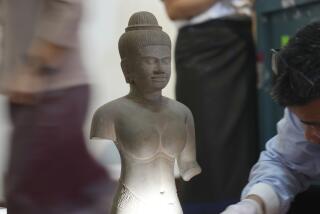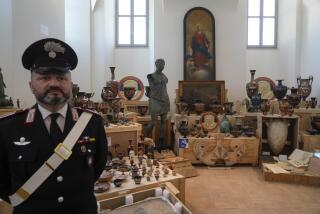Museums turn over ancient art as smuggling investigation presses on
It sounds like an Indiana Jones movie, but Operation Hidden Idol is very real -- an active federal investigation into a former New York-based art and antiquities dealer, the Immigration and Customs Enforcement agency said Wednesday.
As previously reported in the Los Angeles Times, Subhash Kapoor, 65, has been charged with running a $100-million artifacts smuggling ring -- among the largest of such operations in the world, officials said. He is awaiting trail in Chennai, India, where he has pleaded not guilty.
The New York Times reported this week that some American museums including the Peabody Essex in Salem, Mass., and the Honolulu Museum of Art have begun to return objects in their collections associated with Kapoor and his defunct Madison Avenue business, Art of the Past.
The Los Angeles County Museum of Art and the Norton Simon Museum in Pasadena confirmed to the Los Angeles Times on Wednesday that they have objects associated with Kapoor but said they have not been contacted by federal agents involved in the investigation.
“If we were approached we would cooperate,” said Miranda Carroll, spokeswoman for LACMA, which has 62 objects linked to Kapoor, including an iron inkstand from Pakistan circa 1850-1870 and a design for a powder primer flask from India circa 1800. “We don’t believe any objects at LACMA are at issue.”
LACMA researches each work to be added to its collection, Carroll said, by interviewing donors or sellers and gathering information on provenance. “Works in our collection continue to be researched, exhibited, published and listed on our website,” she said. “We continue to re-examine provenances, conferring with scholars and monitoring recent publications.”
The Norton Simon has two small terra cotta figures that were donated by Kapoor in 1997.
“We have not been contacted by federal authorities but will cooperate if contacted,” museum spokeswoman Leslie Denk said.
Federal agents did get in touch with the Honolulu Museum of Art, museum director Stephan Jost said. A museum visitor had seen a 2,000-year-old rattle that was labeled as a gift from Art of the Past. The visitor notified federal agents, who conducted an undercover investigation.
The museum went through its collections registry to identify and give up any pieces that arrived via Kapoor’s gallery. It found six other items matching pieces that were part of the ICE investigation, museum spokeswoman Lesa Griffith said.
“Genocide, poverty, war -- those are the best friends of looting,” said Jost, noting that his museum is particularly sensitive given the looting its local culture has experienced in the past. “I just think you need to cross-check your vision and mission for your institution with the reputation of someone like Kapoor. Is this the kind of person you want to be doing business with?”
Jost, who was not at the Honolulu museum when the Kapoor acquisitions were made, said he places no judgment on institutions that are verifying whether their Kapoor-related items are legitimate. In his case, he said, it was a simple gut check: A review of the purchases revealed prices that were extraordinarily low, and that should have raised red flags.
Not every item sold by Kapoor was looted or smuggled, Jost said. His museum kept a pair of 18th-century carved wood doors from south India.
ICE spokesman Luis Martinez said Wednesday the investigation remains active.
“We’re not knocking down doors, and we don’t do anything by force,” he said. Rather, the agency relies on tips like the one it got in Honolulu.
“There are more artifacts, and we’re still looking for them,” Martinez said, adding more than $100 million worth of artifacts linked to Kapoor have been seized. “They could be in museums or private collections. They could be anywhere.”
Follow me on Twitter @jessicagelt
More to Read
The biggest entertainment stories
Get our big stories about Hollywood, film, television, music, arts, culture and more right in your inbox as soon as they publish.
You may occasionally receive promotional content from the Los Angeles Times.











